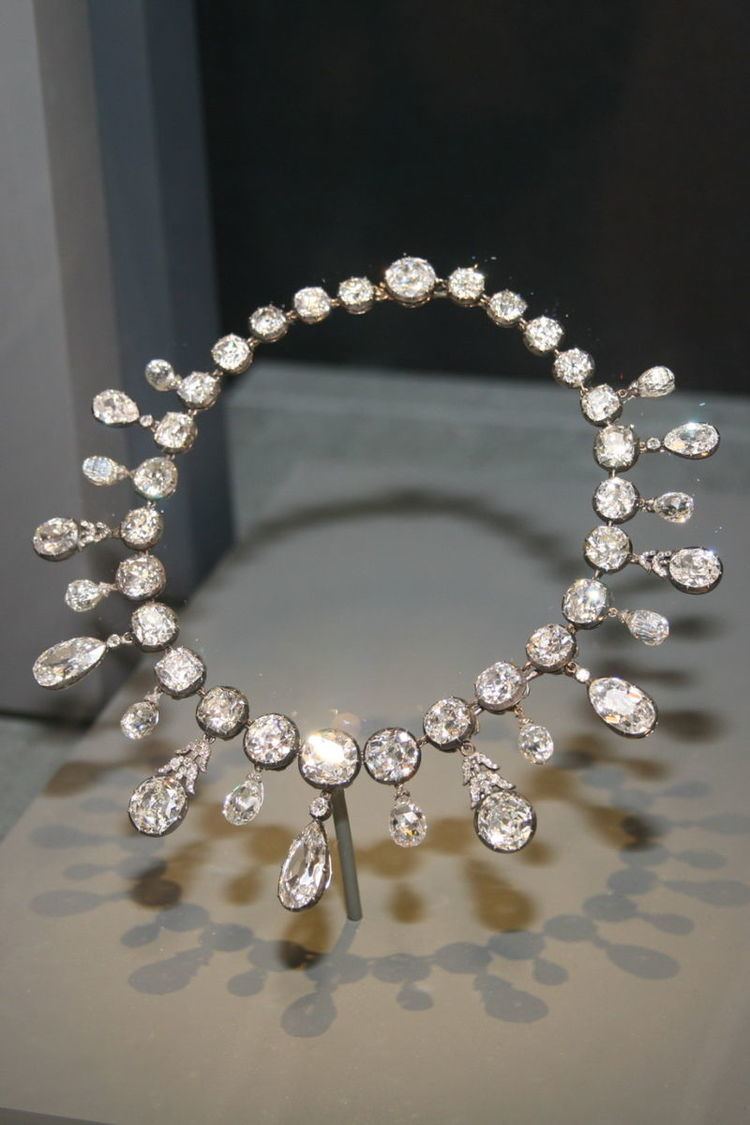 | ||
The Napoleon Diamond Necklace is a diamond necklace commissioned by Napoleon I of France c. 1811–1812. It is currently on display in the Smithsonian Institution in Washington, D.C., United States.
Contents
Description
The Napoleon Diamond Necklace consists of 28 mine cut diamonds set into a single thread, with a fringe of alternating pendeloque and briolettes diamond cuts. The five pear-shaped pendoloques are each mounted below a small brilliant cut diamond. The four ovaline pendeloques are mounted above designs which incorporate 23 brilliant cut diamonds each. Each briolette mounting is set with 12 rose cut diamonds.
While the gems of the Napoleon Diamond Necklace have never been professionally graded by a lapidary (as they have never been removed from their mountings), infrared spectroscopic analysis of the diamonds has shown that they are primarily Type Ia. However, 13 of the 52 largest diamonds in the necklace are of the rare Type IIa variety. A number of the Type Ia diamonds show indications of sulfide crystal imperfections.
Marie Louise
In 1810, Napoleon I of France divorced the Empress Joséphine, as she proved to be incapable of producing an heir. He re-married two months later to Archduchess Marie Louise of Austria. Within a year, Marie Louise bore a son. To celebrate, in June 1811 Napoleon I commissioned the Napoleon Diamond Necklace from the Parisian jewellery firm Nitot et Fils, at a cost of 376,274 French francs. This sum was the equivalent of the Empress's entire annual household budget. There are several contemporary portraits of Marie Louise wearing the Napoleon Diamond Necklace, including a number by the artists François Gérard and Giovan Battista Borghesi. Several years later, in 1815, Napoleon was exiled to Saint Helena. Marie Louise returned to Austria with the necklace and owned it until her death.
Inheritance and sales
Upon the death of Marie Louise in 1847, the necklace passed to Archduchess Sophie of Austria, the wife of her brother Archduke Franz Karl of Austria. Two diamonds were removed from the necklace to shorten it, at the request of Princess Sophie. These diamonds were fitted to a pair of earrings, the location of which is now unknown. Following the death of Sophie in 1872, the Napoleon Diamond Necklace was jointly inherited by her three surviving sons, Archdukes Karl Ludwig, Ludwig Viktor, and Franz Joseph of Austria. Karl Ludwig later acquired his brothers' stakes in the necklace, and upon his death in 1914 passed it to his third wife, Maria Theresa of Portugal.
At the start of the Great Depression in 1929, Maria Theresa engaged two people presenting themselves as "Colonel Townsend" and "Princess Baronti" to sell the necklace for US$450,000. Realising that the current economic conditions would make it almost impossible to reach the asking price, the pair began offers at $100,000, signing on Archduke Leopold of Habsburg, the destitute grandnephew of Maria Theresa, to vouch for the necklace's authenticity. Deals were negotiated with the jewelers Harry Winston and Harry Berenson, but eventually the pair sold the necklace to David Michel of New York City for $60,000, of which the pair claimed $53,730 as expenses. When informed of the sale, Maria Theresa took the matter to court, eventually resulting in the recovery of the necklace, the jailing of Archduke Leopold, and the flight of Townsend and Baronti from the authorities.
After resolving the incident, Maria Theresa held the necklace until her death in 1944. Four years later, the Habsburg family sold it to the French industrialist Paul-Louis Weiller. In 1960, Weiller sold the Napoleon Diamond Necklace to Harry Winston, who believed that the historical value of the piece would make it more valuable than if the stones were removed and resold individually, as was common practice at the time. As such, he kept it intact, reselling it the same year to Marjorie Merriweather Post. Post donated the necklace to the Smithsonian Institution in 1962, and it has since remained on display at the National Museum of Natural History in Washington, D.C., United States.
